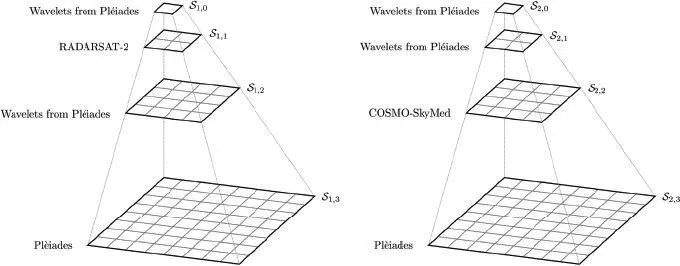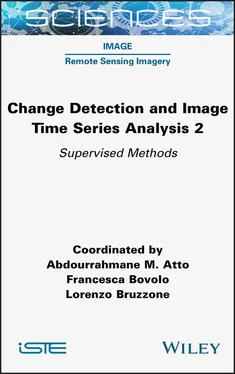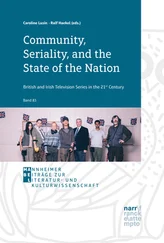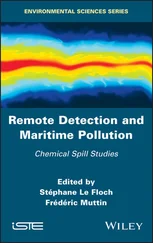As proven in Laferté et al. (2000) and Hedhli et al. (2016), under suitable conditional independence assumptions, the posterior marginal  can be recursively expressed as a function of the posterior marginal
can be recursively expressed as a function of the posterior marginal  of the parent node s– in the same quad-tree and, in the case k = 2, also of the posterior marginal
of the parent node s– in the same quad-tree and, in the case k = 2, also of the posterior marginal  of the parent node s =in the previous quad-tree:
of the parent node s =in the previous quad-tree:
[1.5] 
where  collects all sites except the root in the k -th quad-tree ( k = 1, 2) and X sis a vector collecting the features of all of the descendants of site s . Through this formulation, MPM takes into consideration the information conveyed by the input multisensor data within the labeling of each site
collects all sites except the root in the k -th quad-tree ( k = 1, 2) and X sis a vector collecting the features of all of the descendants of site s . Through this formulation, MPM takes into consideration the information conveyed by the input multisensor data within the labeling of each site 
1.2.3. Hierarchical model associated with the second proposed method
In the second proposed method, the case-specific problem of jointly classifying a multimission, multifrequency (radar X band, radar C band and optical VNIR) and multiresolution series of images acquired by COSMO-SkyMed, RADARSAT-2 and Pléiades is addressed. All of these sensors support multiple spatial resolutions, up to 0.5 m for Pléiades, approximately 1 m for COSMO-SkyMed and 1 m × 2 m for RADARSAT-2.
Let us propose a time series of three images, collected by COSMO-SkyMed, RADARSAT-2 and Pléiades, in the same area, at times close enough to assume land cover stability. A case-specific hierarchical model, again using two quad-trees in cascade, is introduced to generate a supervised classification map at the finest among the spatial resolutions of the input images in the series. Unlike in the case of the hierarchical model of the first proposed approach, in which distinct quad-trees are related to different sensors, in this second approach, for each of the two considered radar sensors, the input image is included in a separate quad-tree according to its spatial resolution (see Figure 1.5). These resolutions are generally expected to be coarser than the finest resolution that is observed through Pléiades. Hence, the input Pléiades data are inserted in the finest resolution layers of both aforementioned quad-trees (see Figure 1.5). The rationale is to both benefit from all input multisensor imagery and to map land cover at the finest resolution available. Empty layers of each of the two quad-trees are filled in with wavelet transforms computed from the Pléiades image included in the leaves layer (see Figure 1.5). The Markovian formulation defined in the previous section, the recursive equations [1.5]and the remarks on the power-of-2 relation among the resolutions of the input images in the series are also valid in this case.

Figure 1.5. Cascaded quad-trees associated with the second proposed method. In this example, we assume that the input time series includes Pléiades data at a 0.5 m resolution, COSMO-SkyMed spotlight data at a 1 m resolution and RADARSAT-2 data sampled on a 2 m pixel lattice. Accordingly, the Pléiades image is included in the leaves layer of both quad-trees. The COSMO-SkyMed and RADARSAT-2 images are inserted in the intermediate layers of separate quad-trees, according to their resolutions. The empty layers of both quad-trees are filled in with wavelet transforms of the Pléiades imagery
1.2.4. Multisensor hierarchical MPM inference
Equation [1.5]allows us to calculate the posterior marginal  at each site
at each site  of the second quad-tree (except the root) recursively, as long as the probabilities
of the second quad-tree (except the root) recursively, as long as the probabilities  become known. In particular, the focus on the second quad-tree is consistent with the cascade approach used within the proposed methods: given the input time series, the output classification map is obtained on the leaves of this second quad-tree (or on the leaves of the last quad-tree in the case of a longer time series).
become known. In particular, the focus on the second quad-tree is consistent with the cascade approach used within the proposed methods: given the input time series, the output classification map is obtained on the leaves of this second quad-tree (or on the leaves of the last quad-tree in the case of a longer time series).
Specifically, under appropriate assumptions, in Hedhli et al. (2016) we proved that, for all 
[1.6] 
where  is the parent–child transition probability across the two quad-trees, P(cs) is the prior probability, P(cs- |cs=) is the transition probability between two sites at the same scale and
is the parent–child transition probability across the two quad-trees, P(cs) is the prior probability, P(cs- |cs=) is the transition probability between two sites at the same scale and  is the partial posterior marginal probability. Given the obvious constraint
is the partial posterior marginal probability. Given the obvious constraint  equation [1.6]determines
equation [1.6]determines  uniquely on all sites
uniquely on all sites  To determine these probabilities, the approach developed in Hedhli et al. (2016) for the multitemporal single-sensor case is generalized to the multisensor tasks considered here. This process is formalized within three recursive passes across the second quad-tree – one bottom-up and two top-down passes – which are described in the next sections.
To determine these probabilities, the approach developed in Hedhli et al. (2016) for the multitemporal single-sensor case is generalized to the multisensor tasks considered here. This process is formalized within three recursive passes across the second quad-tree – one bottom-up and two top-down passes – which are described in the next sections.
1.2.4.1. Initializing on the first quad-tree
First, in order to initialize the process, classification is performed using only the data included in the first quad-tree through a classical MPM on a single quad-tree. We refer the reader to Laferté et al. (2000) for more detail. Here, we only briefly recall that the algorithm is initialized by choosing the prior distribution on the root of this first quad-tree. In order to favor spatial regularity, this prior is selected here according to a Potts MRF model (Li 2009; Kato and Zerubia 2012). Details can be found in Hedhli et al. (2016). From the perspective of the classification of the input series of multisensor images, the key point is that, after this initialization stage, the posterior marginal  is known for each site
is known for each site  of the first quad-tree. Furthermore,
of the first quad-tree. Furthermore,  is also obtained as an intermediate byproduct on the same sites.
is also obtained as an intermediate byproduct on the same sites.
Читать дальше

 can be recursively expressed as a function of the posterior marginal
can be recursively expressed as a function of the posterior marginal  of the parent node s– in the same quad-tree and, in the case k = 2, also of the posterior marginal
of the parent node s– in the same quad-tree and, in the case k = 2, also of the posterior marginal  of the parent node s =in the previous quad-tree:
of the parent node s =in the previous quad-tree:
 collects all sites except the root in the k -th quad-tree ( k = 1, 2) and X sis a vector collecting the features of all of the descendants of site s . Through this formulation, MPM takes into consideration the information conveyed by the input multisensor data within the labeling of each site
collects all sites except the root in the k -th quad-tree ( k = 1, 2) and X sis a vector collecting the features of all of the descendants of site s . Through this formulation, MPM takes into consideration the information conveyed by the input multisensor data within the labeling of each site 

 at each site
at each site  of the second quad-tree (except the root) recursively, as long as the probabilities
of the second quad-tree (except the root) recursively, as long as the probabilities  become known. In particular, the focus on the second quad-tree is consistent with the cascade approach used within the proposed methods: given the input time series, the output classification map is obtained on the leaves of this second quad-tree (or on the leaves of the last quad-tree in the case of a longer time series).
become known. In particular, the focus on the second quad-tree is consistent with the cascade approach used within the proposed methods: given the input time series, the output classification map is obtained on the leaves of this second quad-tree (or on the leaves of the last quad-tree in the case of a longer time series).

 is the parent–child transition probability across the two quad-trees, P(cs) is the prior probability, P(cs- |cs=) is the transition probability between two sites at the same scale and
is the parent–child transition probability across the two quad-trees, P(cs) is the prior probability, P(cs- |cs=) is the transition probability between two sites at the same scale and  is the partial posterior marginal probability. Given the obvious constraint
is the partial posterior marginal probability. Given the obvious constraint  equation [1.6]determines
equation [1.6]determines  uniquely on all sites
uniquely on all sites  To determine these probabilities, the approach developed in Hedhli et al. (2016) for the multitemporal single-sensor case is generalized to the multisensor tasks considered here. This process is formalized within three recursive passes across the second quad-tree – one bottom-up and two top-down passes – which are described in the next sections.
To determine these probabilities, the approach developed in Hedhli et al. (2016) for the multitemporal single-sensor case is generalized to the multisensor tasks considered here. This process is formalized within three recursive passes across the second quad-tree – one bottom-up and two top-down passes – which are described in the next sections. is known for each site
is known for each site  of the first quad-tree. Furthermore,
of the first quad-tree. Furthermore,  is also obtained as an intermediate byproduct on the same sites.
is also obtained as an intermediate byproduct on the same sites.










